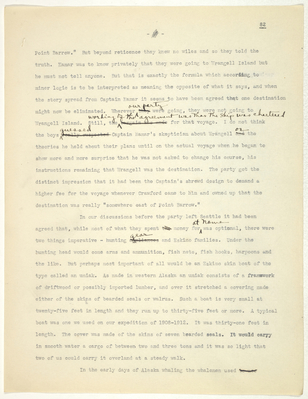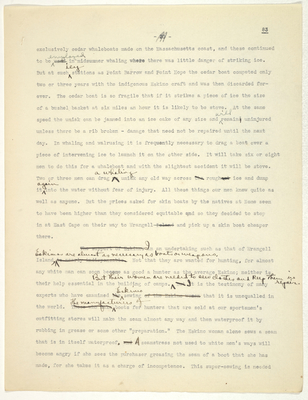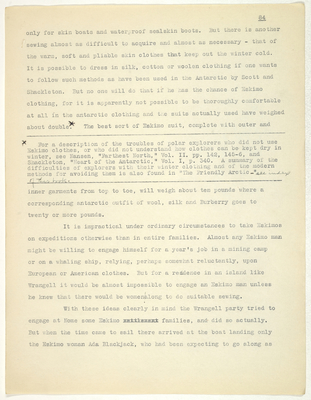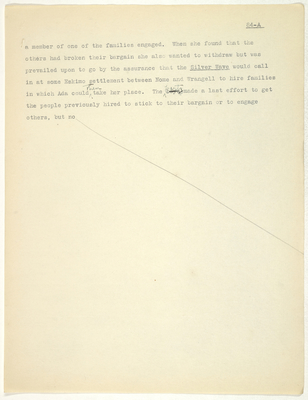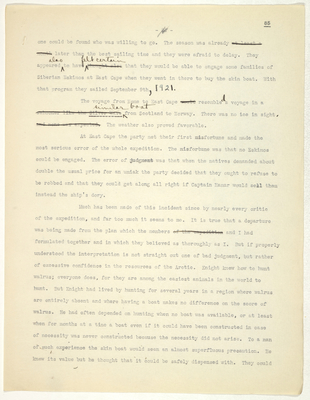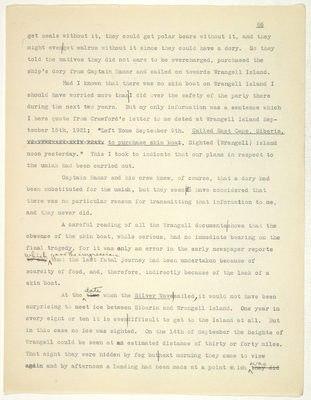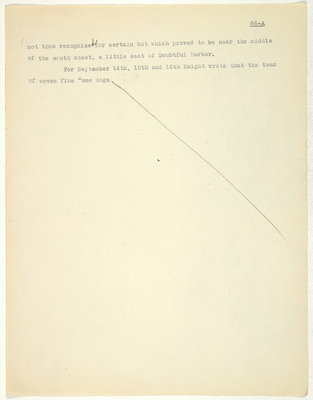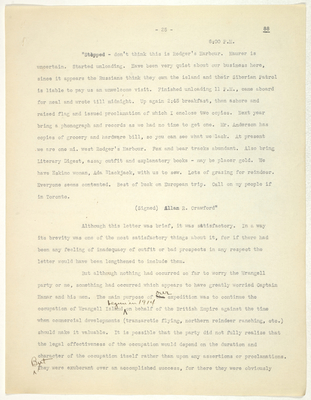Pages That Need Review
stefansson-wrangel-09-27
stefansson-wrangel-09-27-040
81
- 19 -
gold miner might think that gold and its probable discovery would be the one subject for reliable judgment; but the reverse is the case. The prospector who is hardheaded and practical on every other subject will swallow the fishiest yarn where gold is concerned. There is only one way in which you can make it difficult for yourself to spread a rumor about the discovery of gold and that is by talking loudly and freely. Assume secrecy or even the slightest reticence as to where you have been or where you are about to go and rumors of gold "strikes" will grow day by day and spread until some night half a dozen parties set out, each trying to do so without the knowledge of the others and each following some clue to which no rational person would pay any attention.
The Wrangell Island party had been markedly reticent on the passenger steamer from Seattle, and in consequence the rumor of some sort of gold discovery had already germinated among their fellow passengers before they got to Nome. The outfit they were buying seemed curious and, from the Alaska point of view, certainly inadequate for a party going to any uninhabited region. This gave the theorisers two '’facts" to work on. Gold had been discovered, and it must be in the vicinity of some trading post where the party could buy the supplies which they were net taking with them. Few gold miners have been on the north coast of Alaska, but there is current the general knowledge that the arctic coast has a string of fur trading posts. Obviously these were being relied upon by Crawford's party. Possibly some of these remote fur traders might even be, in secret league with us. Accordingly, it became pretty definitely known that their destination was "somewhere east of Point Barrow."
The owner of the schooner Silver Wave was Captain Jack Hamar. When Crawford went to him with a proposal to charter his boat for a voyage to an unnamed destination the skipper quite properly refused to negotiate unless he were let into the secret. Had our party understood better the gold miner's psychology they might perhaps have said that they were going "somewhere east of
stefansson-wrangel-09-27-041
82
- 18 -
Point Barrow.” But beyond reticence they knew no wiles and so they told the truth. Hamar was to know privately that they were going to Wrangell Island but he must not tell anyone. But that is exactly the formula which according to miner logic is to be interpreted as meaning the opposite of what it says, and when the story spread from Captain Hamar it seems to have been agreed that one destination might now be eliminated. Wherever our party they were going, they were not going to Wrangell Island. Still, the working of the agreement was that the ship was chartered bargain was made for that voyage. I do not think the boys guessed really suspected Captain Hamar's skepticism about Wrangell and or the theories he held about their plans until on the actual voyage when he began to show more and more surprise that he was not asked to change his course, his instructions remaining that Wrangell was the destination. The party got the distinct impression that it had been the Captain's shrewd design to demand a higher fee for the voyage whenever Crawford came to him and owned up that the destination was really "somewhere east of Point Barrow."
In our discussions before the party left Seattle it had been agreed that, while most of what they spent the money for at Nome was optional, there were two things imperative - hunting appliances gear and Eskimo families. Under the hunting head would come arms and ammunition, fish nets, fish hooks, harpoons and the like. But perhaps most important of all would be an Eskimo skin boat of the type called an umiak. As made in western Alaska an umiak consists of a framework of driftwood or possibly imported lumber, and over it stretched a covering made either of the skins of bearded seals or walrus. Such a boat is very small at twenty-five feet in length and they run up to thirty-five feet or more. A typical boat was one we used on our expedition of 1908-1912. It was thirty-one feet in length. The cover was made of the skins of seven bearded seals. It would carry in smooth water a cargo of between two and three tons and it was so light that two of us could carry it overland at a steady walk.
In the early days of Alaska whaling the whalemen used to use
stefansson-wrangel-09-27-042
83
- 20 -
exclusively cedar whaleboats made on the Massachusetts coast, and these continued to be employed used in midsummer whaling where there was little danger of striking ice. But at such icy stations as Point Barrow and Point Hope the cedar boat competed only two or three years with the indigenous Eskimo craft and was then discarded forever. The cedar boat is so fragile that if it strikes a piece of ice the size of a bushel basket at six miles an hour it is likely to be stove. At the same speed the umiak can be jammed into an ice cake of any size and will remains uninjured unless there be a rib broken - damage that need not be repaired until the next day. In whaling and walrusing it is frequently necessary to drag a boat over a piece of intervening ice to launch it on the other side. It will take six or eight men to do this for a whaleboat and with the slightest accident it will be stove. Two or three men can drag an a whaling umiak any old way across the roughed ice and dump it again into the water without fear of injury. All these things our men knew quite as well as anyone. But the prices asked for skin boats by the natives at Nome seem to have been higher than they considered equitable and so they decided to stop in at East Cape on their way to Wrangell Island and pick up a skin boat cheaper there.
The support of Eskimos In an undertaking such as that of Wrangell Island, Eskimos are almost as neccesary as boats or weapons.is nearly indispensable Not that they are wanted for hunting, for almost any white man can soon become as good a hunter as tha average Eskimo; neither is their help essential in the building of camps. But their women are needed to sew clothes and keep them in repair. But It is the testimony of many experts who have examined the Eskimos sewing of the Eskimo women that it is unequalled in the world. Those who make The manufacturers of boots for hunters that are sold at our sportsmen’s outfitting stores will make the seam almost any way and then waterproof it by rubbing in grease or some other "preparation." The Eskimo woman alone sews a seam that is in itself waterproof. and A seamstress not used to white men's ways will become angry if she sees the purchaser greasing the seam of a boot that she has made, for she takes it as a charge of incompetence. This super-sewing is needed
stefansson-wrangel-09-27-043
84
only for skin boats and waterproof sealskin boots. But there is another sewing almost as difficult to acquire and almost as necessary - that of the warm, soft and pliable skin clothes that keep out the winter cold. It is possible to dress in silk, cotton or woolen clothing if one wants to follow such methods as hare been used in the Antarctic by Scott and Shackle ton. But no one will do that if he has the chance of Eskimo clothing, for it is apparently not possible to be thoroughly comfortable at all in the antarctic clothing and the suits actually used have weighed about doubl.* The best sort of Eskimo suit, complete with outer and
------------------------------------------------------------------------------------------------------ For a description of the troubles of polar explorers who did not use Eskimo clothes, or who did not understand how clothes can be kept dry in winter, see Nansen, "Farthest North," Vol. II. pp. 142, 145-6, and Shackleton, "Heart of the Antarctic" Vol. I, p. 340. A summary of the difficulties of explorers with their winter clothing and of the modern methods for avoiding them is also found in "The Friendly Arctic-" see index of this book. __________________________________________________________
inner garments from top to toe, will weigh about ten pounds where a corresponding antarctic outfit of wool, silk and Burberry goes to twenty or more pounds.
It is impractical under ordinary circumstances to take Eskimos on expeditions otherwise than in entire families. Almost any Eskimo man might be willing to engage himself for a year’s job in a mining camp or on a whaling ship, relying, perhaps somewhat reluctantly, upon European or American clothes. But for a readence in an island like Wrangell it would be almost impossible to engage an Eskimo man unless he knew that there would be womenalong to do suitable sewing.
With these ideas clearly in mind the Wrangell party tried to engage at Nome some Eskimo XEttismaKfc families, and did so actually. But when the time came to sail there arrived at the boat landing only the Eskimo woman Ada Blackjack, who had been expecting to go along as
stefansson-wrangel-09-27-044
84-A
a member of one of the families engaged. When she found that the others had broken their bargain she also wanted to withdraw but was prevailed upon to go by the assurance that the Silver Wave would call in at some Eskimo settlement between Home and Wrangell to hire families in which Ada could then take her place. The entry made a last effort to get the people previously hired to stick to their bargain or to engage others, but no
stefansson-wrangel-09-27-045
85
- 22 -
one could be found who was willing to go. The season was already at least a month later than the best sailing time and they were afraid to delay. They appeared also to have felt certain thought also that they would be able to engage some families of Siberian Eskimos at East Cape when they went in there to buy the skin boat. With that program they sailed September 9th, 1921.
The voyage from Nome to East Cape would resembled a voyage in a schooner like the Silver Wave similar boat from Scotland to Norway. There was no ice in sight, and none was expected. The weather also proved favorable.
At East Cape the party met their first misfortune and made the most serious error of the whole expedition. The misfortune was that no Eskimos could be engaged. The error of judgment was that when the natives demanded about double the usual price for an umiak the party decided that they ought to refuse to be robbed and that they could get along all right if Captain Hamar would sell them instead the ship's dory.
Much has been made of this incident since by nearly every critic of the expedition, and far too much it seems to me. It is true that a departure was being made from the plan which the members of the expedition and I had formulated together and in which they believed as thoroughly as I. But if properly understood the interpretation is not straight out one of bad judgment, but rather of excessive confidence in the resources of the Arctic. Knight knew how to hunt walrus; everyone does, for they are among the easiest animals in the world to hunt. But Knight had lived by hunting for several years in a region where walrus are entirely absent and where having a boat makes no difference on the score of walrus. He had often depended on hunting when no boat was available, or at least when for months at a time a boat even if it could have been constructed in case of necessity was never constructed because the necessity did not arise. To a man of such experience the skin boat would seem an almost superfluous precaution. He knew its value but he thought that it could be safely dispensed with. They could
stefansson-wrangel-09-27-046
86
get seals without it, they could get polar bears without it, and they might ever get walrus without it since they could have a dory. So they told the natives they did not care to be overcharged, purchased the ship’s dory from Captain Hamar and sailed on towards Wrangell Island.
Had I known that there was no skin hoat on Wrangell Island I should have worried more than I did over the safety of the party there during the next two years. But my only information was a sentence which I here quote from Crawford’s letter to me dated at Wrangell Island September 15th, 1921; "Left Nome September 9th. Called East Cape, Siberia, [XgxkMRilxk.kxxSxlkxkihlkx] to purchase skin boat. Sighted (Wrangell) island noon yesterday." This I took to indicate that our plans in respect to the umiak had been carried out.
Captain Hamar and his crew knew, of course, that a dory had been substituted for the umiak, but they seem to have considered that there was no particular reason for transmitting that information to me, and they never did.
A careful reading of all the Wrangell documents shows that the absence of the skin boat, while serious, had no immediate bearing on the final tragedy, for it was anly an error in the early newspaper reports to say which gave the impression that the last fatal journey had been undertaken because of scarcity of food, and, therefore, indirectly because of the lack of a skin boat.
At the date time when the Silver Wave sailed, it would not have been surprising to meet ice between Siberia and Wrangell Island. One year in every eight or ten it is even difficult to get to the Island at all. But in this case no ice was sighted. On the 14th of September the heights of Wrangell could be seen at an estimated distance of thirty or forty miles. That night they were hidden by fog but next morning they came to view again and by afternoon a landing had been made at a point which was they did
stefansson-wrangel-09-27-047
86-A
not then recognized for certain but which proved to be near the middle of the south coast, a little east of Doubtful Harbor.
For September 14th, 15th and 16th Knight wrote that the team of seven fine Nome dogs
stefansson-wrangel-09-27-048
87
- 24 -
were "in rather poor shape but will do my best to get them in good condition when we reach the island. The season is getting late and a good many things must be done before the freezeup, so we are anxious to get started with our work.”
On September 15th Knight wrote notes that "We sighted (today) a high sandspit with a great deal of wood on it and landed our outfit in a heavy surf. Everything was landed by 10:30 P.M. Started unloading at 7:00 P.M." September 16th: "After unloading we slept on the ship but the wind arose from the south and we were called at 3 A.M. We had time to get our personal stuff ashore and the Silver Wave departed with three whistles and a great deal of flag dipping, and left us to our own resources. We have a good outfit and the fox tracks look promising, so we should have a successful winter. The surprising thing to me is the weather, nice gentle winds with an uncommon amount of sunshine for this time of year, and not an ice cake in sight. "We see an occasional seal some distance out but if they were killed it is doubtful if we could get them ... I had a shot a a large walrus but missed."
Chapter VII
When the Silver Wave sailed away "with much flag dipping," a silence fell upon Wrangell Island that remained unbroken for two years. she carried Captain Hamar brought out with him only the briefest letters either to me or to friends and families. It had been to each of the four an exciting adventure since they left Seattle and especially so between Nome and Wrangell. Apart from personal greetings my only report from them was a letter from Crawford which I quote in full:
"Sept. 15th, 1921, 5:30 P.M. Off Wrangell Island.
"Dear Mr. Stefansson:
"Commencing this letter 1/2 mi. offshore. Left Nome Sept. 9th. Called East Cape, Siberia, to purchase skin boat. Sighted island noon yesterday. Resembles in outline & color country round Lewiston, Idaho. Large flat spaces near coast but seems to be mostly hilly. Snow on highest of hills looks like this year's. Have as yet seen not a single ice cake.
The Difficulties of 1922.
stefansson-wrangel-09-27-049
- 25 -
88
6:00 P.M.
’'Stepped - don’t think this is Rodger’s Harbour. Maurer is uncertain. Started unloading. Have been very quiet about our business here, since it appears the Russians think they own the island and their Siberian Patrol is liable to pay us an unwelcome visit. Finished unloading 11 P.M., came aboard for meal and wrote till midnight. Up again 2:45 breakfast, then ashore and raised flag and issued proclamation of which I enclose two copies. Next year bring a phonograph and records as we had no time to get one. Mr. Anderson has copies of grocery and hardware bill, so you can see what we lack. At present we are one mi. west Rodger’s Harbour. Fox and bear tracks abundant. Also bring Literary Digest, assay outfit and explanatory books - may be placer gold. We have Eskimo vroman, Ada Blackjack, with us to sew. Lots of grazing for reindeer. Everyone seems contented. Best of luck on European trip. Call on my people if in Toronto.
(Signed) Allan R. Crawford”
Although this letter was brief, it was satisfactory. In a way its brevity was one of the most satisfactory things about it, for if there had been any feeling of inadequacy of outfit or bad prospects in any respect the letter would have been lengthened to include them.
But although nothing had occurred so far to worry the Wrangell party or me, something had occurred which appears to have greatly worried Captain Hamar and his men. The main purpose of our expedition was to continue the occupation of Wrangell Island beginning in 1914 on behalf of the British Empire against the time when commercial developments (transarctic flying, northern reindeer ranching, etc.) should make it valuable. It is possible that the party did not fully realize that the legal effectiveness of the occupation would depend on the duration and character of the occupation itself rather than upon any assertions or proclamations. But they were exuberant over an accomplished success, for there they were obviously

